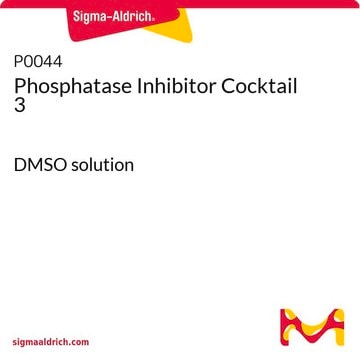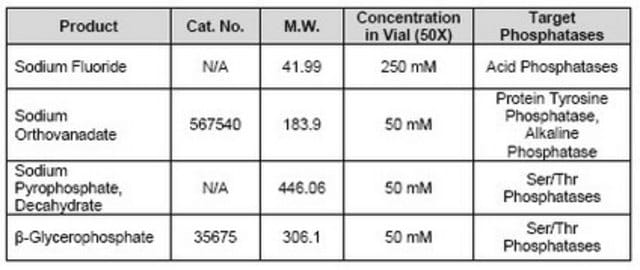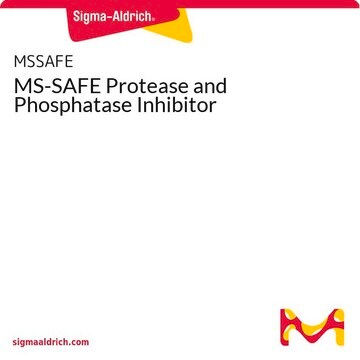524625
Phosphatase Inhibitor Cocktail II
liquid, for the inhibition of acid phosphatases, alkaline phosphatases and protein tyrosine phosphatases (PTP's). Suitable for use with cell lysates and tissue extracts.
Sinonimo/i:
Phosphatase Inhibitor, Phosphatase Inhibitor Solution (Set II)
About This Item
Prodotti consigliati
Nome del prodotto
Phosphatase Inhibitor Cocktail Set II, A cocktail of five phosphatase inhibitors for the inhibition of acid and alkaline phosphatases as well as protein tyrosine phosphatases (PTPs). Suitable for use with cell lysates and tissue extracts.
Livello qualitativo
Stato
liquid
Produttore/marchio commerciale
Calbiochem®
Condizioni di stoccaggio
OK to freeze
Solubilità
water: soluble
Condizioni di spedizione
wet ice
Temperatura di conservazione
−20°C
Descrizione generale
Applicazioni
- in triple detergent buffer to lyse cultured cells to extract total protein for western blots[1]
- as a component of lysis buffer to lyse tissue samples or cultured rat ventricular cardiomyocytes (VCMs) for western blot analysis of cardiac mitochondrial proteins[2]
- as a component of lysis buffer to lyse cultured rat VCMs infected with Adv-COX7RP and Adv-shRNA COX7RP for immunoprecipitation of ryanodine receptors type 2 (RyR2) [2]
- as a component in ice-cold RIPA buffer to homogenize/lyse retina tissues for protein extraction and western blotting[3]
Azioni biochim/fisiol
Caratteristiche e vantaggi
- Flexible: compatible with cell lysates and tissue extracts, including samples containing detergents.
- Economical: ready-to-use format minimizes wastage.
- Effective: one ml is adequate for approximately 100 ml extraction buffer.
- Complete: contains five phosphatase inhibitors targeting acid and alkaline phosphatases and protein tyrosine phosphatases (PTPs).
Componenti
- Imidazole (200 mM)
- Sodium Fluoride (100 mM)
- Sodium Molybdate (115 mM)
- Sodium Orthovanadate (100 mM)
- Sodium Tartrate Dihydrate (400 mM)
Attenzione
Altre note
Note legali
Avvertenze
Danger
Indicazioni di pericolo
Consigli di prudenza
Classi di pericolo
Eye Irrit. 2 - Repr. 1B - Skin Irrit. 2
Codice della classe di stoccaggio
6.1D - Non-combustible acute toxic Cat.3 / toxic hazardous materials or hazardous materials causing chronic effects
Classe di pericolosità dell'acqua (WGK)
WGK 2
Punto d’infiammabilità (°F)
Not applicable
Punto d’infiammabilità (°C)
Not applicable
Certificati d'analisi (COA)
Cerca il Certificati d'analisi (COA) digitando il numero di lotto/batch corrispondente. I numeri di lotto o di batch sono stampati sull'etichetta dei prodotti dopo la parola ‘Lotto’ o ‘Batch’.
Possiedi già questo prodotto?
I documenti relativi ai prodotti acquistati recentemente sono disponibili nell’Archivio dei documenti.
I clienti hanno visto anche
Active Filters
Il team dei nostri ricercatori vanta grande esperienza in tutte le aree della ricerca quali Life Science, scienza dei materiali, sintesi chimica, cromatografia, discipline analitiche, ecc..
Contatta l'Assistenza Tecnica.













